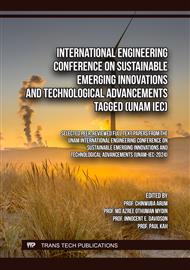[1]
International Energy Agency. World energy outlook 2020. Report 2020, International Energy Agency, Paris, 2020.
DOI: 10.1787/3f36f587-en
Google Scholar
[2]
International Energy Agency. World energy outlook 2024. Report, International Energy Agency, Paris, 2024.
Google Scholar
[3]
J. Aghaei and M. Alizadeh. A smart grid approach for demand-side management. Energy, 58:102–115, 2013.
Google Scholar
[4]
H.T. Banks and K. Kunisch. Bang-bang control problems and applications. Springer, 1984.
Google Scholar
[5]
Boland. Optimal Control Models for Distributed Energy Resources. Renewable Energy, 2020.
Google Scholar
[6]
R.E. Brown. Impact of smart grid on distribution system design. IEEE Power and Energy Society General Meeting, pages 1–4, 2008.
Google Scholar
[7]
L. Cesari. Optimization - Theory and Applications: Problems with Ordinary Differential Equations. Springer-Verlag, New York, 1983.
Google Scholar
[8]
On Climate Change et al. Intergovernmental panel on climate change. World Meteoro- logical Organization, 52(1-43):1, 2007.
Google Scholar
[9]
Y. Chen, Z. Wang, and X. Liu. Bang-bang control in energy systems: A practical guide. Control Engineering Practice, 94:64–73, 2019.
Google Scholar
[10]
K. Deb. Multi-Objective Optimization Using Evolutionary Algorithms. Wiley, Chich- ester, UK, 2001.
Google Scholar
[11]
A.F. Filippov. Differential equations with discontinuous right-hand sides. Mathematics of the USSR-Sbornik, 5(4):443–471, 1964.
Google Scholar
[12]
Bloomberg New Energy Finance. Battery pack prices were below $100/kwh for the first time in 2023. Report, Bloomberg New Energy Finance, 2023. Battery Price Survey Reports.
Google Scholar
[13]
R. Garcia and S. Patel. Battery storage systems for load balancing in smart grids. IEEE Transactions on Sustainable Energy, 11(4):892–903, 2020.
Google Scholar
[14]
P. Gonzalez and J. Smith. Design considerations for turbine longevity in renewable energy systems. Renewable Energy, 30(4):545–555, 2005.
Google Scholar
[15]
M. Johnson, P. Gupta, and T. Lee. Microgrids and smart grids in developing nations. Energy Policy Journal, 18(1):12–25, 2021.
Google Scholar
[16]
F. Katiraei and M. Iravani. Power management strategies for a microgrid with multiple distributed generation units. IEEE Transactions on Power Systems, 21(4):1821–1831, 2006.
DOI: 10.1109/tpwrs.2006.879260
Google Scholar
[17]
D.G. Luenberger. Optimization by Vector Space Methods. Wiley, New York, 1969.
Google Scholar
[18]
G. M'boungui, A.A. Jimoh, and T.T. Ayodele. On the adaptation of south africa experience to combine solar energy and smart grid in Namibia. Africon, Pointe aux Piments, pages 1–5, 2013.
DOI: 10.1109/afrcon.2013.6757707
Google Scholar
[19]
J.D. McCalley and J.D. Weber. Infrastructure needs grid modernization and resiliency. Electric Power Systems Research, 65(2):119–132, 2003.
Google Scholar
[20]
United Nations. Affordable and clean energy for all. Report, United Nations, 2021. Sustainable Development Goals Report.
DOI: 10.18356/76b7f030-en
Google Scholar
[21]
J. Nocedal and S.J. Wright. Numerical Optimization. Springer Science & Business Media, 1999.
Google Scholar
[22]
J. Nocedal and S.J. Wright. Numerical Optimization. Springer, New York, NY, 2nd edition, 2006. ISBN 978-0387303031.
Google Scholar
[23]
K.M. Owolabi, K.C. Patidar, and A. Shikongo. Numerical solutions for a problem arising in angiogenic signaling. AIMS Mathematics, 4(1):43–63, 2019.
DOI: 10.3934/math.2019.1.43
Google Scholar
[24]
S. Panteli and P. Mancarella. Influence of extreme weather and climate change on the resilience of power systems: Impacts and mitigation strategies. IEEE Transactions on Smart Grid, 2015.
DOI: 10.1016/j.epsr.2015.06.012
Google Scholar
[25]
L.S. Pontryagin, V.G. Boltyanskii, R.V. Gamkrelidze, and E.F. Mishchenko. The Math- ematical Theory of Optimal Processes. Interscience Publishers, New York, 1962.
Google Scholar
[26]
R. Rena. The impact of global economic crisis on the Namibian economy: Issues and challenges. Review of Business and Technology Research (RBTR), 3(1):475, 2010.
Google Scholar
[27]
A. Rohit and Y. Sood. Multi-objective optimization for smart grid using evolutionary algorithms. IEEE Transactions on Smart Grid, 9(5):4338–4349, 2018.
Google Scholar
[28]
W. Rudin. Principles of Mathematical Analysis. McGraw-Hill, 1976.
Google Scholar
[29]
H. Taylor and D. Martinez. Co2 emissions and economic considerations in smart grids. Journal of Environmental Management, 22(2):201–217, 2018.
Google Scholar
[30]
W. Tushar and T. Saha. Control engineering for real-time smart grid applications. IEEE Transactions on Industrial Informatics, 16(6):3865–3876, 2020.
Google Scholar
[31]
J.R. Young. Smart grid technology in the developing world. Seattle Pacific, Seattle Pacific University, 1969.
Google Scholar
[32]
Liu Y. Wang F. Zhang H. Zhang, W. and J. Li. Advances in smart grid technology and its applications in sustainable energy systems. Renewable and Sustainable Energy Reviews, 82:3075–3088, 2018.
Google Scholar
[33]
W. Zhang and L. Wang. Multi-objective optimization in smart grid design with environmental constraints. IEEE Access, 7:12465–12477, 2019.
Google Scholar
[34]
Y. Zhang and X. Liu. Advanced materials for solar pv systems and their impact on durability. Materials Science Reports, 35:235–251, 2022.
Google Scholar


